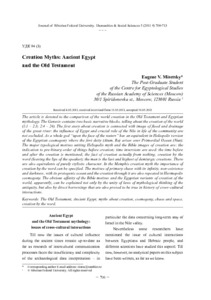Показать сокращенную информацию
Мифология творения: Египет и Ветхий Завет
| Автор | Мисецкий, Е.В. | ru |
| Автор | Misetsky, Eugene V. | en |
| Дата внесения | 2011-05-24T04:35:39Z | |
| Дата, когда ресурс стал доступен | 2011-05-24T04:35:39Z | |
| Дата публикации | 2011-05 | en |
| URI (для ссылок/цитирований) | https://elib.sfu-kras.ru/handle/2311/2362 | |
| Аннотация | The article is devoted to the comparison of the world creation in the Old Testament and Egyptian mythology. The Genesis contains two basic narrative blocks, telling about the creation of the world (1:1 - 2:3; 2:4 - 24). The first story about creation is connected with image of flood and drainage of the great river: the influence of Egypt and crucial role of the Nile in life of the community are not excluded. As a whole god upon the face of the waters has an equivalent in Heliopolis version of the Egyptian cosmogony where the first deity (Atum, Ra) arises over Primordial Ocean (Nun). The major typological motives uniting Heliopolis myth and the Bible images of creation are: the indication to pre-binary order of things before creation; time inversions are used: the time before and after the creation is mentioned; the fact of creation actually from nothing, creation by the word (leaving the lips of the speaker); the man is the last and highest of demiurgic creations. There are also equivalents of purely stylistic character. In the Memphis creation myth the importance of creation by the word can be specified. The motives of primary chaos with its infinity, non-existence and darkness, with its protogenic ocean and the creation through it are also repeated in Hermopolis cosmogony. The obvious affinity of the Bible motives and the Egyptian variants of creation of the world, apparently, can be explained not only by the unity of laws of mythological thinking of the antiquity, but also by direct borrowings that are also proved to be true in history of cross-cultural interactions. | en |
| Аннотация | Вопросы культурного влияния в ветхозаветную эпоху до сих пор остаются достаточно спорными, так как исследование процессов межкультурной коммуникации сталкивается с недостаточностью и сложностью истолкования археологических данных - в частности, данных, касающихся многолетнего пребывания Израиля в долине Нила. Очевидная близость мотивов библейского и египетских вариантов творения мира, очевидно, объясняется не только единством законов мифологического мышления древности, но и прямыми заимствованиями, что подтверждается и историей взаимоотношений культур. | ru |
| Язык | en | en |
| Издатель | Сибирский федеральный университет. Siberian Federal University. | en |
| Является частью серии | 2011 4 ( 5 ) | en |
| Является частью серии | Журнал Сибирского федерального университета. Гуманитарные науки. Journal of Siberian Federal University. Humanities & Social Sciences. | en |
| Тема | The Old Testament | en |
| Тема | Ancient Egypt | en |
| Тема | myths about creation | en |
| Тема | cosmogony | en |
| Тема | chaos and space | en |
| Тема | creation by the word | en |
| Тема | Ветхий Завет | ru |
| Тема | Древний Египет | ru |
| Тема | мифы творения | ru |
| Тема | космогония | ru |
| Тема | хаос и космос | ru |
| Тема | творение словом | ru |
| Название | Мифология творения: Египет и Ветхий Завет | ru |
| Альтернативное название | Creation Myths: Ancient Egypt and the Old Testament | en |
| Тип | Journal Article | |
| Тип | Published Journal Article | |
| Контакты автора | Мисецкий, Е.В. : Центр египтологических исследований РАН , Россия 123001, Москва, ул.Спиридоновка, 30/1 , e-mail: rintra@rambler.ru | ru |
| Контакты автора | Misetsky, Eugene V. : The Post-Graduate Student of the Centre for Egyptological Studies of the Russian Academy of Sciences (Moscow) , 30/1 Spiridonovka st., Moscow, 123001 Russia , e-mail: rintra@rambler.ru | en |
| Страницы | 706-713 | en |

